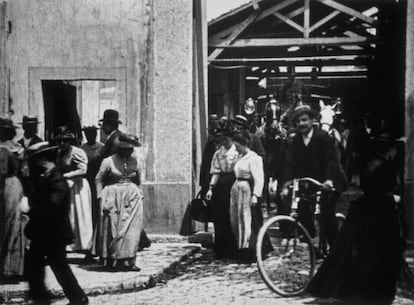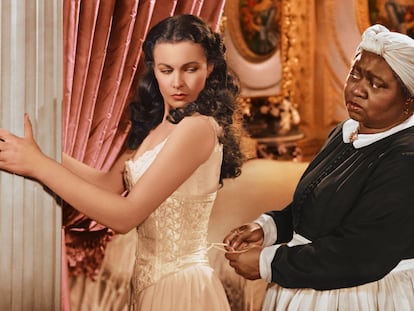Breaking the algorithm: Why are some tweeters watching 100-year-old movies?
A Twitter group of Spanish film lovers known as TopFilmTuiter evaluated pre-1920 films and chose D.W. Griffith’s ‘Intolerance’ as their favorite


Twitter has changed — that’s no big news. There’s now a “For You” tab that shows users tweets from people they don’t follow, and even from people they’ve already blocked (thank you, Twitter algorithms). If you are remotely connected to any movie lovers, perhaps you’ve seen a retweet about some very old films, or people chatting about the conventions of film narration in the late 19th and early 20th centuries. Or maybe even some memes of The Arrival of a Train (1896), by the Lumière brothers.
The people tweeting about all these old films have a Twitter account called TopFilmTuiter, a group of 10 people who spent the last few weeks watching and choosing their favorite films released before 1920. A bunch of 20- and 30-somethings voted on the 100 best films of the period and gave D.W. Griffith’s Intolerance (1916) the top spot.
“Discussing pre-1920 silent films is countercultural to the counterculture. These films are strange curiosities, excluded and forgotten,” said Juan Javato, a 26-year-old from Cáceres (western Spain) and a member of TopFilmTuiter. “They’re viewed as archeological relics, like the Incan artifact exhibit you pass through on your way to see the Mona Lisa at the Louvre,” said his friend, Guillermo Martínez, from Avila (central Spain). Both were part of the TopFilmTuiter team that organized this second round of film rankings. The first round was a ranking last summer of the 100 best films in history, won by Alfred Hitchcock’s Vertigo (1958). Since it was a vote for any film in the history of cinema, 117 people took part. The results were a quirky mix of acclaimed films and some offbeat choices, like Speed Racer (2008) by the Wachowski sisters and Miami Vice (2006) by Michael Mann.

The pre-1920 film rankings were not influenced much by popular opinion because, except for a few very dedicated fans, not many people know about this period in cinema. Much more research and exploration was needed. “Almost all of us watched movies we never heard of — I know someone who saw 400 films,” laughs Martínez, noting that many were short films, sometimes just a few seconds long. Anyone who was followed on Twitter by two or more members of TopFilmTuiter (about 800 people) could take part in the voting, so that the final ranking would represent a snapshot of a specific film community.
“We wanted to establish a community, but not an elitist one,” said Martínez. “Still, there has to be a limit for it to be representative. The fun is in the biases. A movie ranking open to everybody like the ones on the Internet Movie Database (IMDb) just represents current mass consumption trends.”
Voters were given about six weeks to submit their choices by April 8. They watched and evaluated works like the series of 141 photographic plates in Transit of Venus (1874), and the evolution of the so-called institutional narrative. “The significant contribution of this film ranking is that it enabled us to observe the evolution of a cinematographic language,” said Juan Javato. “There were tremendous changes in a 15-year span: primitive films led to Griffith’s work and then to full features. When we say primitive, we mean a man with a camera filming another guy planting geraniums, or a girl with her cat. To go from that to Intolerance is crazy,” enthused Guillermo Martínez. “I remember watching one film and the camera suddenly started moving, like on a track. I almost fell off my chair! Imagine — you’ve been watching everything in chronological order, like Lumière’s short films of women doing laundry, and suddenly the camera moves. The feeling of discovery is thrilling.”
A creative and fun network of cinephiles
The TopFilmTuiter group has no connections or experience in the film industry. Guillermo Martínez and Juan Javato have science and business degrees. Both liked the idea of “an outsider’s view of cinema,” said Javato. “This was a creative and fun effort to create a network of cinephiles who enjoy delving deeper to research different periods and directors.” Disseminating information was one motive, but not the primary focus. Many outsiders found TopFilmTuiter and started following the group, but they most enjoyed the internal discussions and recommendations, following up on how friends and collaborators voted, and facilitating access to all the films. Download links were shared for over 100 royalty-free works from around the world, including some by Spanish film director Segundo de Chomón, as well as books, articles and essays on pre-1920 films.

“They say people watch the movies they want to see, but they also watch what they know. I think a positive aspect of initiatives like this is that they lead people to discover films they end up liking,” said Martínez. Rounding out the top three pre-1920 films were pioneering releases like The Vampires, a 1915 French silent crime serial film written and directed by Louis Feuillade that clocked in at 420 minutes, and The President (1919), the first feature film directed by Carl Theodor Dreyer. But the TopFilmTuiter group also explored long-forgotten female directors like Lois Weber. “It doesn’t make any sense that she’s not more well-known. She was the most innovative director of the time along with Griffith,” said Javato. Martínez chimed in: “Lois Weber’s Suspense [1913] looks like a short Hitchcock film. She surprises you with delirious vantage points and bird’s-eye camera angles… Her films are very avant-garde.”
Javato and Martínez predicted a victory by Intolerance. “It’s by the best-known director of the time, and it’s also his most famous, non-toxic film,” said Javato. By ‘non-toxic,’ he was referring to the famous but toxic The Birth of a Nation (1915), Griffith’s paean to the Ku Klux Klan (KKK) and its founder. Widely condemned for its racism, Griffith’s film was nonetheless a significant achievement and made the top 100 list of pre-1920 cinema. “Anyone with a sense of decency will reject the subject of this film. It revived a moribund KKK and created its imaginary to some extent. Cross burning, for example, comes from his film,” he said. Martínez adds, “[The film] was also scandalous back then! And also very perverse in how it portrays the [American] Civil War. The South are the good guys, of course. There’s a subtitle that declares “the Aryan right to exist.” Griffith was 20 years ahead of Leni Riefenstahl [Nazi Germany’s leading filmmaker] in how he distorted reality.”
The cinephiles
Besides Javato and Martínez, the TopFilmTuiter group includes Faustino Sánchez, Álvaro Peleteiro, Pedro Crespo, Alicia Castilla, Iván Míguez, Mario Quesada, Alejandro Pérez and Brais Velay. Faustino Sánchez is the architect of TopFilmTuiter’s voting system (voters upload their rankings of 25 films to Letterboxd), which also provides statistics, cross-referenced data, score comparisons and heat maps. This year included a “TopFilmTinder” feature that matches users with others who share the same affinity in movies. “It’s like FilmAffinity’s soulmate feature, but more accurate because of the smaller sample size. I hope someone will use it to find love!” exclaimed Javato. “It’s also an amazing movie recommendation system.” Martínez added, “Faustino is like that. He uploaded the data from last year’s Sight & Sound top movie list and made it so you can filter everything even better than on their website.”
Sight & Sound’s 2022 list caused an uproar among fans for choosing Belgian filmmaker Chantal Akerman’s Jeanne Dielman, 23, quai du Commerce, 1080 Bruxelles (1975), as the best film in the history of cinema. Javato and Martínez say such criticism reflects “a stale taste in films… [Critics] argue that it’s boring, but don’t try to understand why the slow pace makes sense in the film. They don’t see that it’s about a woman who’s a foreigner and the surrounding xenophobia, as if she’s in the movie because of #MeToo or some woke conspiracy,” said Javato. “They talk like the film came out of nowhere, when it has been well-regarded for years,” adds Martinez. “It made previous Sight & Sound rankings even though it wasn’t number one. It also made our TopFilmTuiter list last year.”
The TopFilmTuiter group plans to continue evaluating film history going backward in time decade-by-decade. That vote will happen every winter, while another spring vote will start with the 1920s and move forward through the decades. They are also considering a thematic summer vote but haven’t decided on one yet. “I don’t know if this is the best time for cinephilia as a cultural movement, but I think it’s the best time to be a cinephile. There has never been so much access to such a variety of films. The canon is changing because in the past, it was established by those who had exclusive access and a megaphone to shout their opinions,” said Javato. Guillermo Martínez believes this is why new perspectives and critical criteria are emerging. “There’s room now for other undercurrents of cinephilia that are not the prepackaged opinions of a privileged few that influence so many people.”
Sign up for our weekly newsletter to get more English-language news coverage from EL PAÍS USA Edition
Tu suscripción se está usando en otro dispositivo
¿Quieres añadir otro usuario a tu suscripción?
Si continúas leyendo en este dispositivo, no se podrá leer en el otro.
FlechaTu suscripción se está usando en otro dispositivo y solo puedes acceder a EL PAÍS desde un dispositivo a la vez.
Si quieres compartir tu cuenta, cambia tu suscripción a la modalidad Premium, así podrás añadir otro usuario. Cada uno accederá con su propia cuenta de email, lo que os permitirá personalizar vuestra experiencia en EL PAÍS.
¿Tienes una suscripción de empresa? Accede aquí para contratar más cuentas.
En el caso de no saber quién está usando tu cuenta, te recomendamos cambiar tu contraseña aquí.
Si decides continuar compartiendo tu cuenta, este mensaje se mostrará en tu dispositivo y en el de la otra persona que está usando tu cuenta de forma indefinida, afectando a tu experiencia de lectura. Puedes consultar aquí los términos y condiciones de la suscripción digital.
More information
Archived In
Últimas noticias
Chris Martin, Taylor Swift, Elijah Wood and other famous wedding ‘crashers’
‘How does it feel to be a failure?’: Elizabeth Berkley’s journey from ‘Showgirls’ ridicule to vindication
The story of the Málaga virus: The code that haunted Google’s cybersecurity center director for 30 years
The impact of Ecuador’s mega-prison: A polluted river, cleared forests and military checkpoints
Most viewed
- Christian Louboutin: ‘Young people don’t want to be like their parents. And if their parents wear sneakers, they’re going to look for something else’
- The low-cost creative revolution: How technology is making art accessible to everyone
- All the effects of gentrification in one corner of Mexico’s Colonia Roma
- Liset Menéndez de la Prida, neuroscientist: ‘It’s not normal to constantly seek pleasure; it’s important to be bored, to be calm’
- December Social Security and SSI payments: Dates, double checks and the 2026 COLA increase










































